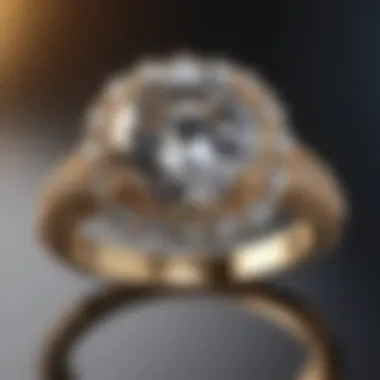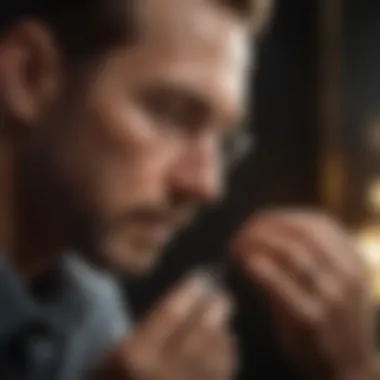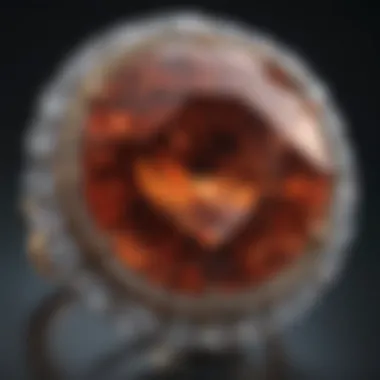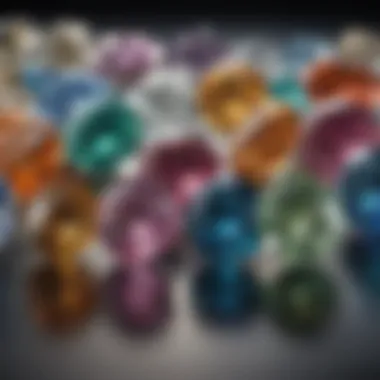Understanding the Value of Your Diamond Ring


Intro
Knowing the worth of a diamond ring can shape your decisions, whether you are selling, buying, or simply appreciating a piece of jewelry. Many factors intertwine in the valuation of diamonds, making this process nuanced and sometimes confusing.
This guide seeks to unveil the intricacies behind diamond valuation, from understanding fundamental aspects to exploring expert methods and tools available in the market. Readers can expect an insightful exploration of how diamonds are assessed, what elements contribute to their value, and the various resources that assist in evaluating these precious stones.
Gemstone Overview
Definition and Characteristics
A diamond is a crystalline form of carbon with noteworthy brilliance and hardness. It is characterized by its clarity, cut, carat weight, and color - commonly referred to as the Four Cs. Each of these characteristics significantly impacts the diamond's overall value.
- Clarity refers to the absence of inclusions and blemishes.
- Cut describes how well the diamond has been shaped and faceted.
- Carat weight measures the size of the diamond.
- Color evaluates the hue of the diamond, typically ranging from colorless to light yellow or brown.
This interplay of characteristics contributes to a diamond's unique identity and market worth.
Classification of Gemstones
Gemstones fall into two broad categories: precious and semi-precious. Diamonds belong to the precious category, alongside gems like rubies, emeralds, and sapphires. This classification is mainly rooted in historical value, rarity, and cultural significance rather than just physical properties. Understanding this classification can help in comprehending the market dynamics and customer perceptions.
Historical Significance
Ancient Uses and Cultural Importance
Throughout history, diamonds have held immense value, often associated with power, wealth, and endurance. Ancient cultures believed in diamonds' protective properties, using them as talismans against evil. In various civilizations, including India and Rome, diamonds adorned the crowns and jewelry of royals, reflecting status and abundance.
Myths and Legends Surrounding Gemstones
Diamonds have not only been valued for their brilliance but also surrounded by myths. For instance, some cultures believed that diamonds could bring good fortune and enhance the wearer’s strength. The ancient Greeks thought diamonds were tears of the gods, amplifying their splendor in society.
"A diamond is forever" - this phrase, though a marketing strategy, illustrates the deep-seated belief in diamonds as symbols of eternal love.
Understanding these historical and cultural contexts is pivotal when assessing a diamond’s worth, as they often resonate with personal and collective values.
In continuation, the guide will further detail the valuation methods, tools, and key insights into assessing your diamond ring, providing readers with a comprehensive understanding affected by both market trends and intrinsic qualities.
Intro to Diamond Valuation
Understanding the valuation of a diamond is crucial for any owner, collector, or potential buyer. The process is not only about determining how much a diamond is worth, but also involves a deeper comprehension of its qualities, market trends, and personal significance.
The diamond industry is complex. The value of a diamond is not merely a reflection of its physical properties. It also depends on various market dynamics and the knowledge of the individual assessing it. Knowing the true worth of your diamond can aid in making informed decisions regarding selling, insuring, or acquiring similar pieces.
The Importance of Knowing Your Diamond's Worth
A solid understanding of your diamond's worth serves multiple purposes. First, it empowers owners with the knowledge needed for insurance purposes. Insuring a diamond without knowing its accurate value may lead to insufficient coverage.
Second, in any financial transaction, understanding the worth can ensure a fair deal. This holds especially true when buying or selling. Buyers want to secure the best option, while sellers should be aware to avoid underpricing their asset.
Third, emotional and financial investments are tied to jewelry. Recognizing the intrinsic value of your diamond can provide closure in times of transition, such as inheriting or selling a family heirloom. Additionally, this awareness respects the craftsmanship and time involved in creating these remarkable gems.


Common Reasons for Valuation
Valuation is often sought for several key reasons:
- Insurance Needs: A comprehensive appraisal is required to insure a diamond adequately against theft or loss.
- Market Transactions: Buyers and sellers need accurate valuations to ensure fair pricing during sales.
- Estate Planning: Knowing a diamond's worth can aid heirs and executors in managing estates effectively.
- Personal Record Keeping: Maintaining a record of value over time can help track investment growth or changes in market conditions.
"Understanding what determines a diamond's value allows for educated choices in both emotional and financial contexts."
Ultimately, knowing your diamond's worth is an essential step in maximizing its potential, whether it is imbued with personal significance or designed as a financial investment.
Factors Affecting the Value of a Diamond
Understanding the factors that influence the value of a diamond is essential for any owner or potential buyer. The evaluation of a diamond's worth is not simply about aesthetics; it incorporates grading systems and market conditions. Each of these factors contributes to perceived value, which can fluctuate over time, depending on broader economic and cultural trends. Recognizing these elements allows for more informed decisions when purchasing, selling, or valuing a diamond ring.
The Four Cs of Diamonds
The Four Cs of Diamonds are critical components in determining a diamond's quality and, consequently, its market value. Each of these characteristics provides essential insights into the uniqueness and desirability of a diamond.
Cut
Cut refers to how well a diamond has been shaped and faceted. It is arguably the most important element among the Four Cs since it affects how light interacts with the diamond. A well-cut diamond will exhibit brilliance and sparkle, enhancing its visual appeal.
The key characteristic of Cut is its direct impact on sparkle. An ideal cut maximizes light return, making the diamond more captivating to the eye. This quality is particularly beneficial because the aesthetic value of diamonds is often a high priority for buyers.
However, not all cuts are created equal. A poorly cut diamond may appear dull regardless of its other qualities. Therefore, ensuring a significant focus on the cut can raise the overall value of the diamond ring significantly.
Color
The Color of a diamond is another vital element in valuation. Diamonds are graded on their color scale, which ranges from completely colorless to light yellow or brown. As a general rule, the less color present, the more valuable the diamond.
The key characteristic here is that a colorless diamond often attracts higher premiums. Buyers tend to favor diamonds in the D-E-F range of the color scale, as these diamonds are deemed rare.
On the other hand, diamonds that exhibit color may be less desirable, thus reducing value. It is essential to consider the color when evaluating a diamond for its resale or purchase potential.
Clarity
Clarity pertains to the presence of internal or external flaws, commonly known as inclusions and blemishes. The clarity scale ranges from flawless to included. Flawless diamonds have no visible inclusions when viewed under ten-power magnification, while included diamonds contain significant flaws visible to the naked eye.
The key characteristic of Clarity lies in its rarity. Flawless or nearly flawless diamonds command a higher price due to their exceptional quality and scarcity. If the diamond is marketed for its clarity, it is likely to attract certain collectibles focused on quality.
An example of the unique feature is that even small inclusions can significantly impact value, especially in high-quality diamonds. Very few prospective buyers might overlook this factor, making clarity a paramount consideration.
Carat Weight
Carat Weight measures the weight of the diamond, where one carat equals 200 milligrams. The higher the carat weight, the more valuable the diamond tends to be. However, larger diamonds do not always guarantee higher value due to variations in quality attributes.
The key characteristic of Carat Weight is that it often correlates with luxury and status. Larger diamonds are more visually impressive and tend to attract greater attention.
Nevertheless, buyers should not solely focus on carat weight to determine value. Diamonds with a smaller carat weight but superior cut, color, and clarity may yield a higher overall value compared to larger, lower-quality stones.
Market Trends and Demand


Market trends directly impact the demand for diamonds. When the economy is strong, more consumers are likely to invest in luxury items such as diamond rings. On the other hand, economic downturns can significantly reduce demand for such items. The popularity of vintage and ethically sourced diamonds can also influence current market trends. Buyers should stay informed about these shifts.
Brand Reputation and Retailer Influence
The reputation of the brand and the retailer also plays a significant role in diamond valuation. Recognized brands often command higher prices due to their established reputation for quality and craftsmanship. Consumers tend to trust these retailers because of their stringent sourcing and grading practices. This factor should not be discounted when valuing a ring, as branded items frequently carry a premium even if the Four Cs are similar to a non-branded piece.
Methods for Valuing Your Diamond Ring
The valuation of a diamond ring is not a straightforward process. Various methods exist to determine its worth, and understanding these methods is crucial for anyone looking to appraise their diamond accurately. The most reliable methods include professional appraisals, online calculators, and comparative market analysis. Each method has its benefits and limitations, and knowing them can help make informed decisions regarding your diamond's value.
Professional Appraisals
Choosing a Qualified Appraiser
A qualified appraiser plays a vital role in the diamond valuation process. Selecting someone with experience and credentials can significantly impact the accuracy of the appraisal. A good appraiser should have certification from recognized organizations such as the American Society of Appraisers or the International Society of Appraisers. The key characteristic of choosing a qualified appraiser is their expertise in grading diamonds based on the Four Cs – cut, color, clarity, and carat weight. Choosing an expert ensures a professional evaluation that aligns with current market conditions.
One unique feature of professional appraisers is their access to tools and resources that most consumers do not have. This can provide insights into market trends, historical sales data, and comparable valuations. The primary disadvantage, however, is the cost associated with these services, which can be a barrier for some individuals.
Understanding Appraisal Reports
Understanding appraisal reports is essential once you've had your diamond ring appraised. These reports typically outline the diamond's characteristics, its estimated market value, and any specific conditions or notes that may affect its worth. A key characteristic of appraisal reports is their detailed nature. They provide a breakdown of the Four Cs and other relevant information that aids in valuing the diamond. This makes them a beneficial resource for both buyers and sellers.
A unique feature of appraisal reports is the comparability they provide. They serve as a documented basis for value, which can be advantageous when selling or insuring the diamond. However, not all appraisals will have the same value due to different market conditions and the appraiser’s subjective view, which can lead to inconsistencies.
Use of Online Calculators
Functionality of a Diamond Ring Worth Calculator
Online calculators can offer a quick and accessible way to estimate the value of your diamond ring. These tools typically require specific inputs, such as the diamond's carat weight, color grade, clarity grade, and cut quality. The key characteristic of these calculators is their convenience; they are often free and can provide an instant estimate of worth based on average market values.
One unique feature of diamond ring worth calculators is the speed at which they function. You can quickly compare values from different sources and gain a general idea of your diamond's market status. However, it’s important to note that these calculators may not always consider regional differences, personal factors, or fluctuations in the diamond market, which can lead to inaccuracies.
Limitations of Online Tools
Despite their convenience, online valuation tools come with notable limitations. They typically rely on general datasets rather than on specific market conditions or unique characteristics of your diamond. This can result in a wide variance in estimated values. The key characteristic of online tools is their inability to provide a personal touch; they cannot evaluate the individual nuances that a professional appraisal might capture.
A significant limitation is that these calculators lack the expertise that a professional might offer. Factors such as crafting, jewelry settings, and even market trends can alter the worth of a diamond, and these nuances are often overlooked in generic calculations.
Comparative Market Analysis
Comparative market analysis is an invaluable method for understanding the value of your diamond ring in relation to similar items in the market. This approach involves researching recent sales of comparable diamonds to gain a clearer picture of your diamond’s worth. By examining listings and sales data from trusted sources, you can make informed decisions regarding pricing.
This method allows for a comprehensive understanding of current market dynamics, trends, and buyer preferences. However, like any assessment, it relies heavily on the quality of the data you gather. Always ensure that the diamonds you are comparing are similar in grade and characteristics to obtain an accurate valuation.
In summary, the methods for valuing your diamond ring are diverse and offer various avenues for understanding its worth. From professional appraisals giving an in-depth perspective to quick online calculators providing instant assessments, each has its role in the valuation process. Keep in mind their respective advantages and limitations, ensuring you choose the best approach for your needs.
Using a Diamond Worth Calculator
Using a diamond worth calculator can significantly streamline the process of determining the value of your diamond ring. This tool integrates complex data into a user-friendly interface, allowing individuals to gauge worth with relative ease. There are many benefits to utilizing this technology.
One critical advantage is time-saving. Instead of navigating through various methods or contacting multiple appraisers, these calculators provide a quick estimate. They assess several factors, such as the four Cs—cut, color, clarity, and carat weight—all in one place. Additionally, online calculators can give a rough estimate to help you make informed decisions regarding your diamond's worth.


However, consideration must be taken when using these tools. Not all calculators are created equal. The accuracy of the estimate can be influenced by the data you input and the specific algorithms the calculator uses. Thus, it's vital to approach the results with a critical eye, recognizing that a digital tool can help but should not be the sole source of valuation.
How to Input Data Accurately
Inputting data accurately into a diamond worth calculator is essential. Precision in your details will lead to a more reliable estimate. Start with the basic parameters:
- Carat Weight: Enter the weight of the diamond in carats. This is a straightforward measurement, often marked on certificates.
- Cut: Define the diamond's cut quality. Options range from Excellent to Poor. The cut affects how light interacts with the diamond, influencing its overall beauty.
- Color Grade: Specify the color of the diamond. It is graded from D (colorless) to Z (light yellow or brown). Understanding this grading will help in entering more accurate data.
- Clarity: Input the clarity rating, which ranges from Flawless to Included. This grade indicates the presence of inclusions or blemishes.
Special attention should be paid to these parameters because small inaccuracies can result in significant discrepancies in valuation. Ensure that all information by cross-referencing with reliable sources like the GIA.
Interpreting Calculator Outputs
After you have input all the necessary data, interpreting the calculator's output is the next step. Generally, outputs will present an estimated value range for your diamond. Here’s how to assess this information:
- Value Range: Look for the lowest and highest estimates provided. Understanding this range helps you gauge market fluctuations and potential selling prices.
- Factors Consideration: Some calculators might highlight which factors had the most influence on the final estimation. This breakdown can help you realize the importance of each characteristic.
- Compare with Market Trends: Take the estimated value and compare it with recent sales data from reputable jewelry retailers. This step can give you context about your diamond's worth.
- Seek Expertise: If the values seem significantly lower or higher than expected, consider getting a professional appraisal. Digital calculations may not account for all variables
Common Misconceptions About Diamond Valuation
Understanding the common misconceptions about diamond valuation is essential for anyone looking to accurately assess the worth of their diamond ring. Many individuals enter the process with biases or incomplete information, which can lead to significant discrepancies between perceived and actual value. Addressing these misconceptions not only aids in realistic appraisals but also empowers buyers and sellers alike when navigating the complex world of diamonds. The relevance of this discussion extends to ensuring that gemstone enthusiasts, collectors, and jewelry designers make informed choices, enhancing their knowledge and confidence in the valuation process.
Misunderstanding the Emotional Value
Emotional value often plays a crucial role in how individuals perceive the worth of their diamond rings. Many people assume that this personal sentiment translates into monetary worth, but this is not necessarily the case. Emotional attachments develop from significant life events, such as engagements or anniversaries. However, when it comes to actual resale or appraisal, such feelings do not hold substantial weight.
Examining the difference between emotional and market value is critical. While the sentimental value may be immeasurable for one owner, potential buyers will prioritize factors such as the diamond's quality, market demand, and current trends. This gap in perception can lead to unsatisfactory appraisal outcomes when individuals expect to receive prices reflective of their personal connections rather than market conditions.
Overestimating the Impact of Size
Another prevalent misconception is the notion that a larger diamond always equals a higher value. While carat weight is one of the significant factors in diamond valuation, it is not the sole indicator. The overall quality of the diamond, including its cut, color, and clarity, often has more impact on the price than size alone.
Buyers often fixate on the size of the diamond, leading to inflated expectations regarding worth. For instance, a two-carat diamond with poor cut or color may sell for less than a one-carat diamond with exceptional clarity and brilliance. When assessing diamond rings, it is vital to see beyond just the size and consider the overall quality and characteristics that contribute to the true value.
"A high-quality smaller diamond can be more valuable than a larger one with significant flaws."
Clarifying these misunderstandings is fundamental in making informed decisions about diamond rings. Whether someone is considering a purchase or seeking an appraisal, recognizing the importance of both emotional and size-related misconceptions can lead to a more educated understanding of their diamond's true worth.
Final Thoughts on Diamond Valuation
Valuing a diamond ring is not merely a task of assigning a price; it involves a deeper understanding of its unique characteristics and market dynamics. This section encapsulates the key themes discussed throughout the article, emphasizing the need for an informed approach to diamond valuation. A comprehensive grasp of valuation can aid both the seller and the buyer in making sound decisions.
The Role of Expert Opinions
Expert opinions play a crucial role in the world of diamond valuation. Jewelers and appraisers use years of training and experience to assess diamonds accurately. They consider both quantifiable metrics and subjective nuances that might affect a diamond's value. For instance, while the Four Cs—cut, color, clarity, and carat weight—are foundational, personal expertise can shed light on unique characteristics that might elevate a diamond’s worth beyond basic measures.
It is not unusual for someone to misjudge the value of a diamond simply based on online calculators or personal research. Professional insights can clarify misunderstandings about worth based on sentimental value, historical context, and even regional market differences. Therefore, consulting with an expert often leads to a more accurate and reliable valuation of your diamond ring.
Making Informed Decisions
The process of valuing a diamond should lead to informed decisions that consider various perspectives. Understanding how to assess both intrinsic and extrinsic value is essential. Buyers should know what factors increase a diamond's worth. Sellers should likewise understand how to present their diamonds effectively, maximizing potential returns.
Here are some considerations for making well-informed choices:
- Research Thoroughly: Gathering information on market trends and consumer demand can provide context for your valuation.
- Trust but Verify: While expert opinions are valuable, it is necessary to obtain more than one valuation for cross-reference.
- Consider Emotional Factors: Recognizing the emotional worth of your diamond is crucial, yet it should not overshadow practical valuation considerations.
"Knowing the actual value of your diamond can prevent regrettable decisions that may appear financially beneficial short-term but are detrimental long-term."
In summary, understanding diamond valuation requires a blend of different approaches. Leveraging expert opinions while conducting independent research can lead to well-rounded insights. Armed with valid information, individuals can navigate the complexities of diamond transactions more competently.







